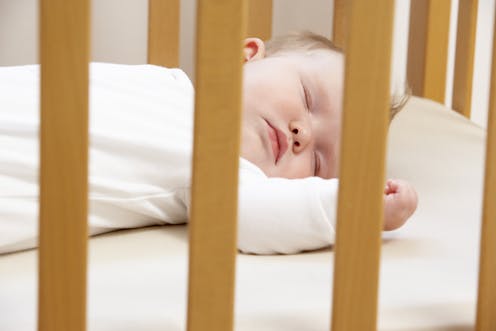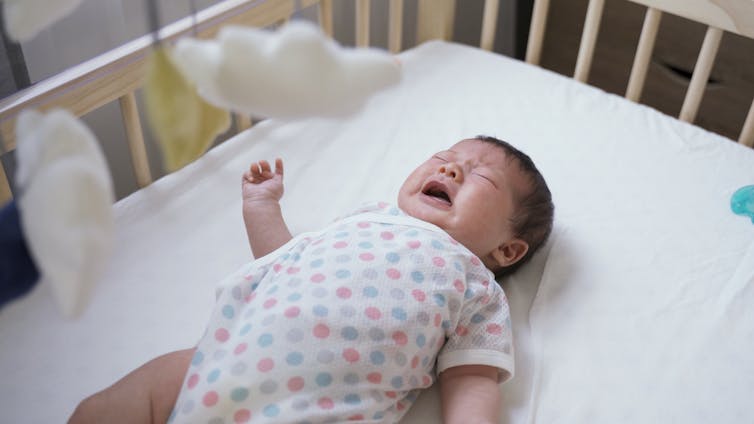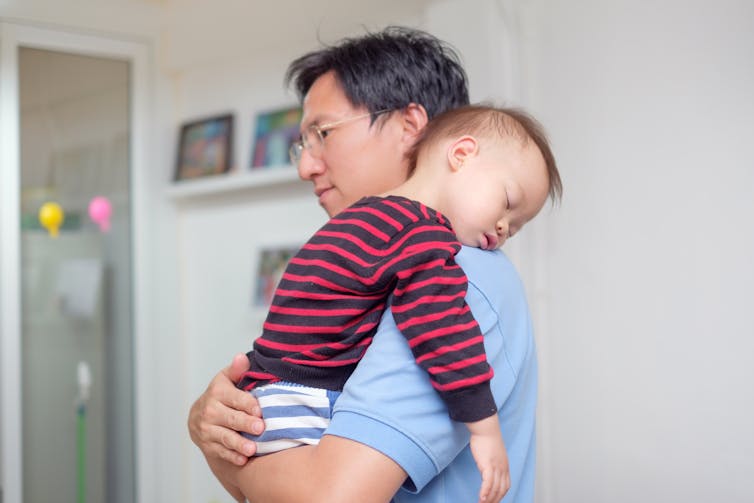Source: The Conversation (Au and NZ) – By Anna Price, Team Leader / Senior Research Officer, Murdoch Children’s Research Institute

Most new parents and caregivers will know the phrase “put your baby down when drowsy but awake”. But some parents may find this just doesn’t work for them. As soon as the baby goes into the cot, they start screaming!
Talking with other parents about how to get a baby to sleep can be as divisive as talking religion or politics. It can feel as though there is only one “right” way of doing things.
But as researchers and clinicians supporting families with child and baby sleep, we can reassure you no one way suits all babies or families.
A baby’s natural temperament, age and feeding pattern are among many factors that influence its sleep. Babies often change their sleep patterns as they get older, and it can take time for them to learn how to settle into sleep.
A baby’s environment also influences how it sleeps – siblings, noise, what the family did that day and stress may all play a role. In turn, family circumstances can affect how a baby’s sleep is perceived.
Read more:
1 in 3 new mums struggle to get their baby to sleep, but some women have a tougher time
Understanding normal baby sleep
Sleep happens in cycles. We start out awake, then fall into light sleep and then deep sleep, before moving into wakefulness and so on. For adults, one of these cycles lasts around 90 minutes. For babies and children, it is around half this time.
Every time we go into a light sleep cycle, we may wake briefly. A baby must learn to link sleep cycles to sleep longer. If a baby learns to self-settle, they can link their sleep cycles on their own. If not, they may need help after every light sleep cycle.
Before about six months of age, babies typically wake regularly during the night to feed and get enough nutrients to grow.
After the first few months of life, falling asleep will involve associations – things that are familiar to us – and these associations are learned. If a baby’s sleep associations are with feeding or being in a carer’s arms, they may need this association to fall back to sleep.

Shutterstock
It’s the same for us as grown-ups; if we wake, it can be hard for some of us to get back to sleep if we are missing our usual pillow or blanket, or if a light gets turned on or we can hear a noise.
When thinking about babies and sleep, it’s important to differentiate between the first and the second half of the first year of life. The reason is a key milestone in the baby’s development sometime beyond around four months of age: the understanding of object permanence.
Read more:
Controlled crying is helpful, not harmful
This is when the baby knows a caregiver is still around even when they are not visible or in the room with them. This means that if the baby wakes up at the end of a light sleep cycle and cannot go back to sleep by themselves, they will cry or call out.
Does the ‘drowsy but awake’ advice work?
Some babies will find it harder to self-settle than other babies. The “drowsy but awake” technique is often recommended as a way to help babies develop self-settling techniques.
The idea is to get them used to feeling drowsy when in bed to set up the association between bed and sleep.
Parents can use responsive settling techniques (such as holding or patting) to help their babies and children get ready for sleep.
While the “drowsy but awake” technique hasn’t been rigorously studied on its own, it has been well studied in the context of sleep training.
So what’s the evidence for sleep training?
Sleep training methods that reduce the level of support (incorporating the “drowsy but awake” technique) can help babies build independence in self-settling. The evidence is based on healthy babies, who are typically six months and older.
One of the most widely known sleep training methods is called “controlled comforting” (also known as “controlled crying”). Parents put their baby to bed tired but awake, and leave them to settle for short, increasing periods of time, even if they cry. Parents choose which time intervals are best for their family – for example, two minutes, then four minutes, six minutes, then eight minutes; or two, five, ten minutes; or two, five, five, five minutes.
A more gradual method is called “camping out”. A caregiver lies on a camp bed or sits in a chair next to their baby’s cot to settle the baby when they cry. Over a couple of weeks, the caregiver gradually moves the chair or bed away from the cot and out the door, until the baby is falling asleep without the parent in the room.
Studies show these techniques help parents with their child’s sleep and their own well-being. However, the research is lacking when it comes to cross-cultural context, understanding the perspective of fathers, in children below six months of age, and in families experiencing higher social and economic adversity.
Not every technique works for every baby or every family. If caregivers want to try a new sleep approach, it’s important to have a plan A and plan B. Try plan A with the “ideal” situation but escalate to plan B quickly if plan A doesn’t work. Parents can decide whether to try again another time.

Shutterstock
What can I do to establish healthy sleep habits?
Babies and children thrive on routines. Positive bedtime routines can help children get ready for sleep. This means doing the same things every time before bed, so the baby knows it is sleep time. These may include things that help the baby calm down, like a warm bath or reading a story while keeping the environment calm and soothing to promote sleep.
Learning new routines is often easier for babies and children when they have more energy (typically earlier in the day) and harder when they are more tired.
Read more:
Should I roll my baby back over if she rolls onto her stomach in her sleep?
For more information about children’s sleep and how to manage it:
-
the Raising Children Network website gives all the current evidence on children’s development and sleep by age group and is government-funded and non-profit
-
the Sleep with Kip website offers a range of clinically validated, evidence-informed resources to help understand and support families with sleep. It includes a 90-second “sleep quiz”, which once completed will provide recommendations for simple, actionable sleep strategies to support your child’s sleep, plus information on sleep cycles and the science of normal sleep.
![]()
Billy Garvey receives funding from the NHMRC.
Nothing to disclose.
Anna Price, Ashikin Mohd Nordin, and Valerie Sung do not work for, consult, own shares in or receive funding from any company or organization that would benefit from this article, and have disclosed no relevant affiliations beyond their academic appointment.
– ref. Why are parents told to put their baby to bed ‘drowsy but awake’? Does it work? – https://theconversation.com/why-are-parents-told-to-put-their-baby-to-bed-drowsy-but-awake-does-it-work-183368







